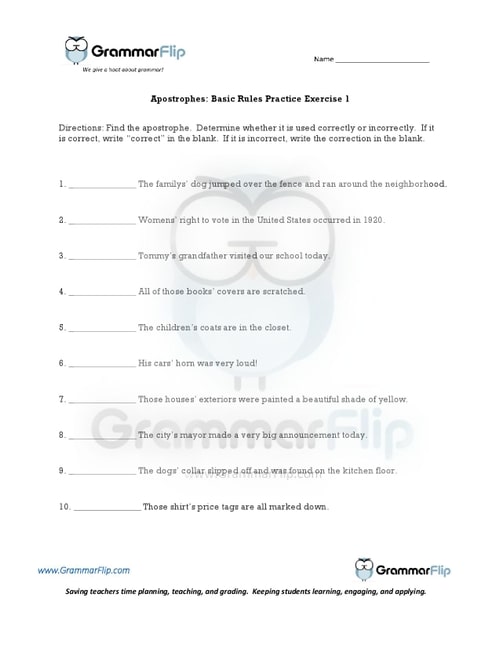
Apostrophes are punctuation marks that are primarily used to show possession and to indicate missing letters in a contracted word.
To show possession of a singular noun, simply place an apostrophe and an -s to the end of the word: Tyrone‘s bicycle, the pencil‘s eraser, the dog‘s collar To show possession of a plural noun that already ends with an -s, simply place an apostrophe at the end of the word: four cats‘ litter boxes, two babies‘ cribs, three teachers‘ gradebooks To show possession of a plural noun that does not end with an -s, simply place an apostrophe and an -s at the end of the word: two women‘s notebooks, four children‘s crayons, three geese‘s feathers
An apostrophe is used to indicate the placement of missing letters in a contracted word: cannot > can’t
do not > don’t
I will > I’ll
is not > isn’t
An apostrophe is used to form the plural of a number or letter. Mind your p’s and q’s.
There are two 7’s in my phone number.
She received all A’s on her report card.

Click the image below to download your free worksheet on the basic rules of apostrophes!
GrammarFlip is a comprehensive grammar and writing program designed to individualize student learning while saving ELA teachers time in the classroom. Built by teachers, for teachers.
Parts of Speech lessons provide the building blocks of grammar. GrammarFlip covers these topics in detail to ensure a solid foundation is built. First time learners and students seeking to review the parts of speech can both benefit from the instructional videos and slide show reviews.
Parts of the Sentence lessons are critical for understanding how the parts of speech function in language construction. From the basic to the advanced, these lessons will cover a wide range of grammar topics that can be used in any grade level or classroom.
Mechanics and Usage lessons equip students with the necessary skills to communicate clearly to all audiences. With a focus on the application of these concepts in student writing, these lessons tie together both simple constructions of grammar as well as the more complex such that any age or skill level of student will benefit.